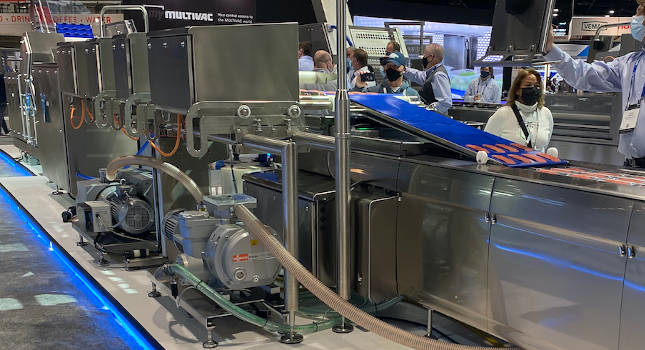Six ways vertical commissioning can benefit a food facility project
Vertical commissioning can significantly improve immediate return on investment (ROI) at start-up due to fewer unexpected challenges.
Vertical Commissioning Insights
- Investing resources upfront and taking the time to properly plan to bring all of the design-build disciplines, facility owners and plant operators together for commissioning purposes during pre-planning and design stages will pay off in the long term.
- A vertical start-up strategy to design-build projects can help avert last-minute crises while also enhancing time to market and reducing installation and start-up costs.
- Collaboration with original equipment manufacturers (OEMs) and working ahead and testing processes are the foundation of successful vertical commissioning projects.
Signing on a new construction or renovation project presents an exciting time for food manufacturing owners ready to embark on the next stage of their business plan. A commissioning partner who uses a vertical start-up model can help ensure a smooth project handover.
Traditionally, commissioning occurs as construction nears completion when engineers begin installing and testing equipment to guarantee production lines will run properly. However, my experience is that waiting until the end to conduct system integration, simulations and automation can prolong start-up and cost owners valuable time, money and resources.
Applying best practices for commissioning and coordinating with owner equipment manufacturers (OEMs) early on can ensure facilities achieve full performance much faster and at a fraction of the cost compared to traditional methodologies.
Why does vertical commissioning matter?
Food plant construction requires many experts working in different areas simultaneously.
However, once specifications and project goals are established in pre-planning, integration isn’t touched again until the final stages of a project when the commissioning engineer begins site inspections.
When communication for all these moving parts is limited to email, actively ensuring that owner project requirements (OPR) are met can become an afterthought. Becoming lax in quality checks and integration often leads to errors and discrepancies revealed during equipment testing. This is where projects will enter a “crisis mode” as designers, engineers and builders scramble to quickly resolve emerging problems and meet the OPRs so the facility can become operational.
Unsurprisingly, this situation can set back a timeline significantly, especially in the current market where supply chain disruptions already threaten to delay projects across the construction industry.
We prefer applying a vertical start-up strategy to our design-build projects, which ensures facilities never enter a last-minute “crisis mode” and offers many benefits to owners such as:
- Improving time to market (TTM)
- Reducing installation costs
- Reducing start-up costs
- Reducing OEM support costs
- Minimizing ingredient losses
- Improving knowledge transfer to site resources.
The idea behind this methodology is that commissioning needs to start sooner rather than later because it’s much easier to plan and troubleshoot during concept and design than during start-up when it’s nearly time for a facility to go online.
Defining optimization needs during conceptual design
It may seem inconvenient to add meetings on top of the many that already occur in the lifecycle of a project. However, investing resources upfront to bring all of the design-build disciplines, facility owners and plant operators together for commissioning purposes during pre-planning and design stages will pay off in the long term.
A manufacturing system is bound to be more comprehensive and robust when there is early and consistent input from the numerous people involved in building and running a successful food manufacturing and processing facility, including engineers, plant operators and maintenance workers.
For example, engineers may understand the specifications of how a piece of equipment fits in a workspace, but the operator has a different degree of insight into the factors that influence production efficiency. By bringing them together to discuss the big picture before making any capital equipment investments, they can collaborate and combine their expertise to define a system that meets every technical need, minimizes downtime and speeds up time to market (TTM).
Why early equipment management and original equipment manufacturers (OEMs) are keys to success
The point of a vertical start-up is to ensure every piece of equipment in a facility’s system is thoughtfully planned and properly connected during the design phase in order to identify potential issues early on in the project schedule. Waiting to conduct testing at start-up isn’t ideal because when someone encounters challenges, they’re at a point where both time and money are running out.
Collaboration, working ahead and testing processes early reduce start-up time and cost. Early equipment management and coordination with original equipment manufacturers (OEMs) are the foundation of successful vertical start-ups. Developing a series of strategies and best practices for achieving an efficient vertical start-up, customized for each facility’s particular needs. For example, proper training and system simulations can give facility operators time to learn and feel comfortable supporting the lines before production ramps up.
Using vertical commissioning to exceed client expectations
Automation technologies are becoming more common in food manufacturing and processing facilities. As systems become more complex, it’s crucial to ensure every part works to perfection. The earlier quality control can begin, the better for the owner.
I once worked with a client who dedicated a year to developing an innovative automation process for their new manufacturing facility. Stellar applied a vertical start-up strategy to the project to ensure the complex system integration occurred smoothly. This positioned our team to hand over the system with minimal changes during start-up, even despite construction delays.
The client kicked off production shortly after equipment installation and testing, with plant operators praising the efficiency of our start-up process. On top of that, the client has had limited OEM support costs since taking ownership from day one.
Vertical commissioning is beneficial and worth the investment in many ways, but the most important is that it can significantly improve immediate ROI at start-up due to fewer unexpected challenges.
This originally appeared on Stellar’s website. Stellar is a CFE Media content partner.
Original content can be found at Stellar.
Do you have experience and expertise with the topics mentioned in this content? You should consider contributing to our CFE Media editorial team and getting the recognition you and your company deserve. Click here to start this process.



